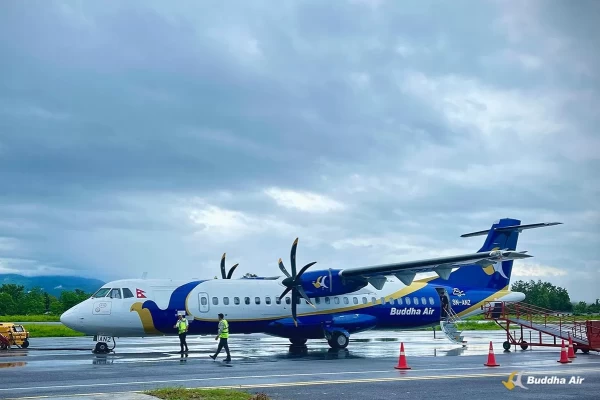Role of Anti-Icing and De-Icing in Winter Flight Safety

It can get icy up there at times. Every ATR Aircraft has intricate de-icing and anti-icing systems inside of them to protect and prevent ice formations during those monsoon and winter frosty flights above the clouds.
In aviation, aircraft safety in cold weather conditions is something we tend to overlook but holds extreme importance. Two critical procedures that help maintain safe flight operations during such times are de-icing and anti-icing. While both processes prevent ice accumulation on aircraft surfaces, they differ in their timing, method, and purpose. Both systems are one of the many small but significant technologies that add to the built-in safety precautions taken to protect from these unpredictable weather conditions.
So what are De-icing and Anti-icing, and why should you know this random piece of aircraft information? Let us find out!
What Is De-icing
Simply, De-icing is a fascinating technology that uses the hot air produced by the engines to circulate through different parts of the aircraft that may likely be touched by ice. It is the process of removing ice, snow, or frost that has already formed on an aircraft’s surfaces, such as the wings, fuselage, and tail. Ice accumulation can negatively impact an aircraft’s performance, potentially disrupting airflow and increasing weight, which can compromise the safety of the flight. De-icing is typically done before takeoff using heated fluids, often a mixture of glycol and water.
In aviation, de-icing is essential because it ensures that the aircraft’s aerodynamic surfaces are clear, allowing smooth airflow during takeoff and flight. This process, while essential, needs to be performed with efficiency and speed to prevent the ice from reforming before the aircraft leaves the ground.
What Is Anti-icing
Anti-icing is a form of ice protection for certain parts of the aircraft, like the windshields, by incorporating a continuous electrical heating system. It is a preventative measure used to stop ice from forming on the aircraft in the first place. Unlike de-icing, which removes existing ice, anti-icing involves applying a protective layer that prevents ice from adhering to the aircraft’s surfaces. This protective layer is often made from a more concentrated glycol-based fluid, which lowers the freezing point of water on the aircraft surfaces.
Anti-icing can be applied before takeoff or in-flight. For instance, anti-icing systems are installed on various aircraft components, such as the wings, engine inlets, and windshields. These systems can include heating elements or chemical sprays that activate during flight when the aircraft enters icy conditions. This is particularly important in ensuring safe operations during prolonged exposure to freezing temperatures.
You may also like: Weather and Aviation: How Airlines Prepare for Extreme Weather Conditions
Key Difference Between Anti-icing and De-icing
Understanding the distinction between de-icing vs anti-icing is crucial to comprehending how both systems work together to keep flights safe. In terms of timing, de-icing is applied after the ice has already formed, while anti-icing is a preventative measure used to stop ice from forming.
The purpose of de-icing is to remove existing ice and snow from the aircraft surfaces. Anti-icing, on the other hand, aims to prevent the formation of ice on critical surfaces in the first place. At the same time, de-icing usually involves heated fluids to melt ice, while anti-icing uses protective fluids or in-built heating systems to prevent ice accumulation. To say it in simple words, anti-icing systems are particularly critical, as they ensure that ice does not form on the aircraft during flight, which could affect its performance and safety. De-icing is more commonly done on the ground, before takeoff, to clear the aircraft of ice.
Anti-icing vs De-icing in Aviation in Nepal
In countries like Nepal, where weather conditions can range from tropical to freezing, ensuring proper de-icing and anti-icing procedures are followed is extremely important for safe air travel. Nepal’s mountainous terrain and cold weather, particularly during the winter, make it essential for aircraft operating in the country to have effective de-icing and anti-icing systems. Buddha Air follows strict safety protocols to ensure that all aircraft are properly prepared for winter conditions. The company utilizes advanced ground and in-flight anti-icing systems, ensuring safe flights for passengers, even in the most challenging weather conditions.
Conclusion
Understanding the difference between de-icing and anti-icing is important in aviation. De-icing ensures that ice is removed before takeoff, while anti-icing prevents ice from forming in the first place. Both methods are essential for ensuring safe and smooth operations, particularly in countries like Nepal, where weather conditions can vary dramatically. By following stringent de-icing and anti-icing protocols, airlines can help prevent any safety issues related to ice accumulation during flight.
FAQs about Anti-icing and De-icing
What is anti-icing in aircraft?
Anti-icing in aircraft is a method used to prevent ice from forming on critical surfaces such as wings, engine inlets, and windshields. This can be achieved through chemical fluids or by using heating elements that keep the surface warm enough to stop ice from forming.
What is the purpose of anti-icing?
The purpose of anti-icing is to prevent the formation of ice on aircraft surfaces during flight or before takeoff. This is critical for maintaining the aircraft’s aerodynamic performance and ensuring passenger safety in cold weather conditions.
